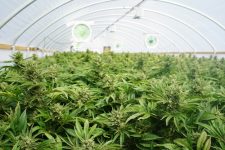We’re Importing Medical Marijuana, While Police Are Raiding Local Producers

The first two commercial batches of legal medicinal cannabis products were imported into Australia earlier this week. The medicines were produced in Canada and are being held by Health House International in WA and the Pharmaceutical Packaging Professionals in Victoria.
The imports are part of an interim fast-track scheme announced by Australian health minister Greg Hunt in February. It’s designed to help fill the gap in the local market, while domestic production grows to meet the nation’s demands.
Thirty import licences have been issued, and more batches are expected to arrive later this month from Canada, Switzerland and the Netherlands. The current shipment of medical-grade cannabis oils are produced by CanniMed and come in three strengths to suit different illnesses.
The arrival of the medical marijuana products will make it more likely that doctors will now prescribe the drug to patients who are suffering from conditions such as nausea from cancer-related chemotherapy, multiple sclerosis and children afflicted with intractable epilepsy.
But just how accessible will it be?
Doctors have already been able to prescribe medicinal cannabis products to patients on a case-by-case basis in Australia. But this involved a long approval process via the Therapeutic Goods Administration (TGA), as well as prolonged waits for the medicine to arrive from overseas.
As of this week, the products will be more readily available for those patients with a prescription. However, for those that don’t have one, the process of actually obtaining a prescription is extremely difficult, as the TGA has not approved cannabis-based medicines as a registered product.
Patients either have to go to a doctor who is part of the Authorised Prescriber Scheme – as of March this year there were only 23 doctors registered to do this nationwide – or a doctor needs to apply on their behalf through the Special Access Scheme.
In both cases, doctors need to convince the TGA that the drug would benefit the patient.
The slow drip of the federal framework
The federal government passed legislationn in February last year allowing for the legal cultivation, manufacture and distribution of medical marijuana. Businesses can apply for a licence to grow the plant and produce medicine as of October last year.
But to many the federal medicinal cannabis regime is a pretence.
The Office of Drug Control only issued the first licence in mid-February. Nine domestic licences have now been granted. Five allow for cultivation for medicinal purposes, three for cultivation for research, but only one actually allows for the manufacture of the products.
Raiding those who are helping the ill
Meanwhile, as all this red tape holds back patients from receiving the medicine they need, there’s a home grown industry flourishing in Australia, albeit illegally.
Medicinal cannabis experts estimate there are around 100,000 patients using the plant products countrywide, with 1,000 dispensaries supplying them.
And as the federal government hurriedly imports the medicine that’s almost impossible to obtain, police are raiding those who are helping sick patients. The Ubuntu Wellness Clinic was raided in Newcastle on December 1 last year. One of the largest suppliers in the country, the clinic had 2,000 clients.
While Jenny Hallam was raided by South Australian police on January 4 this year.
Ms Hallam was supplying around 100 patients throughout the country. She’s now facing up to 10 years imprisonment for providing cannabis oil to patients for free. Even though, it’s a similar product to what the government is importing from overseas.
An Australian medicinal cannabis pioneer
Dr Andrew Katelaris is a medicinal cannabis producer. He began experimenting with the medical uses of the plant in the early 1990s, and he currently acts as a consultant at the Ubuntu Wellness Clinic.
In 1997, Katelaris was granted the state’s first industrial hemp licence and he was also granted a licence to grow medicinal plants in 2001. However, both licences were revoked after the NSW health minister was replaced.
Over recent years, the doctor has been working with over 50 children with serious seizure disorders, including intractable epilepsy, and providing them with medicine. He believes it’s “obscene” that the government is importing medicine from overseas, when it can be and is being produced in Australia.
“We can support the average small child for about $150 a month,” Dr Katelaris told Sydney Criminal Lawyers®. “The equivalent pharmaceutical cannabis from GW Pharmaceuticals is $1,500 a month.”
The problem is the TGA
Australian Greens leader Richard Di Natale introduced the Regulator of Medicinal Cannabis Bill into federal parliament in November 2014. It sought to establish an independent regulator to oversee the establishment of a system of legalised medical marijuana.
But the Health Department had concerns, as the new regulatory system might conflict with the Therapeutic Goods Act. Senator Di Natale stressed the independence of the new system, as the TGA markets pharmaceuticals and doesn’t issue approval for herbal medicines.
The Greens bill was ideal as it sidestepped the TGA, Dr Katelaris explained. However, “Turnbull wouldn’t support that and instead he put up his own bill, which put it under complete TGA control.” This was the Narcotic Drugs Amendment Bill 2016 that was passed in February last year.
According to Katelaris, “the big issue” is that the TGA are trying to turn medical marijuana into a pharmaceutical-only product. While producers like himself don’t have a problem with pharmaceutical cannabis products, they want “unregulated home growing” established as well.
The three-tiered system
Medical marijuana producers in Australia are calling for a moratorium on arrests and an end to prohibition. And as Dr Katelaris outlines they want a three-tiered system to be established, which would comprise of “home growing, proxy growing and pharmaceutical production.”
Home growing would allow people to produce their own medicine cheaply. Proxy growing groups would be set up to cultivate small plantations, providing for people who couldn’t grow their own. And then, pharmaceutical companies registered with the TGA could produce medicine that is only available by prescription.
However, the current system only allows for the third tier: patented medical preparations, which will be produced by big pharmaceutical companies. And as medicinal cannabis advocates will tell you, these products are vastly inferior to the herbal preparations.
“We see it as a food supplement, rather than a drug. They’re trying to make a full pharmaceutical drug out of it, which it’s not,” Dr Katelaris concluded. “The TGA is the price maintenance unit for big pharmaceutical corporations.”
Receive all of our articles weekly
Author

Paul Gregoire






